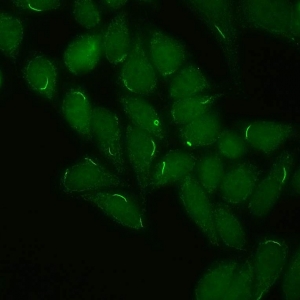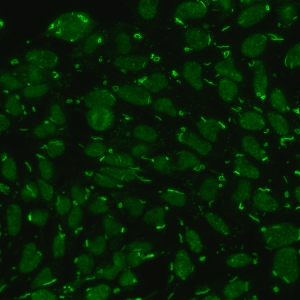     |
|
| Previous Nomenclature | None |
| Description | Distinct rod and ring structures in the cytoplasm of interphase cells. Some smaller rods and rings also reported in the nucleus. |
| Antigen Association | IMPDH2 |
|
Clinical Relevance
First level information About Clinical Relevance & List of Abbreviations |
|
▶ Most commonly found in HCV patients who have been treated with pegylated interferon-α/ribavirin combination therapy, but autoantibodies revealing the AC-23 patterns were undetected prior to treatment; as the use of interferon-α/ribavirin in HCV treatment is decreasing, the frequency and clinical associations of the AC-23 pattern may change (98–101) ▶ Specific immunoassays to detect autoantibodies directed to specific Rods and Rings antigens, for instance IMPDH2, are not commercially available Note: Presence of the AC-23 pattern depends on the HEp-2 cell substrate. |
| First level information references |
|
98. Covini G, Carcamo WC, Bredi E, et al. Cytoplasmic rods and rings autoantibodies developed during pegylated interferon and ribavirin therapy in patients with chronic hepatitis C. Antivir Ther 2012;17:805-11. 99. Calise SJ, Keppeke GD, Andrade LE, et al. Anti-rods/rings: a human model of drug-induced autoantibody generation. Front Immunol 2015;6. 100. Novembrino C, Aghemo A, Ferraris Fusarini C, et al. Interferon-ribavirin therapy induces serum antibodies determining ’rods and rings’ pattern in hepatitis C patients. J Viral Hepat 2014;21:944-9. 101. Keppeke GD, Calise SJ, Chan EK, et al. Anti-rods/rings autoantibody generation in hepatitis C patients during interferon-α/ribavirin therapy. World J Gastroenterol 2016;22:1966-74. |
| Second level information |
|
▶ HCV patients positive for the AC-23 pattern have been reported to have disease that is more resistant to therapy, but this is not confirmed in other cohorts (40) ▶ The AC-23 pattern has also been reported rarely in individuals without HCV infection, including SLE patients and patients under treatment with mycophenolic acid, azathioprine, methotrexate or acyclovir, as well as with lower titers in the general population (39-42) |
| Second level information references |
|
39. Satoh M, Chan EKL, Ho LA, et al. Prevalence and sociodemographic correlates of antinuclear antibodies in the United States. Arthritis Rheum 2012;64:2319-27. 40. Climent J, Morandeira F, Castellote J, et al. Clinical correlates of the "rods and rings" antinuclear antibody pattern. Autoimmunity 2016;49:102-8. 41. Covini G, Carcamo WC, Bredi E, et al. Cytoplasmic rods and rings autoantibodies developed during pegylated interferon and ribavirin therapy in patients with chronic hepatitis C. Antivir Ther 2012;17:805-11. 42. Keppeke GD, Prado MS, Nunes E, et al. Differential capacity of therapeutic drugs to induce Rods/Rings structures in vitro and in vivo and generation of anti-Rods/Rings antibodies. Clin Immunol 2016;173:149-56. |
| FAQ |
|
How to deal with just a “nuclear speckled” IFA report? In my practice I have followed patients with ANA findings, with a nuclear speckled pattern (without specifying whether fine/dense/coarse), in patients with very heterogeneous phenotypes, some with a clinical picture that suggests further investigation of systemic autoimmune disease (one patient with proximal muscle weakness and skin thickening) and others who represent only non-specific findings. In such situations, as a precaution, I request more specific autoantibodies. However, this pattern (nuclear speckled pattern) is not described by the "ICAP" and I am in doubt about which antigenic association it represents, even to guide which autoantibody may be present and which ones to look after. How to interpret this pattern? Does the lab describe it when it is not possible to "refine" such a conclusion? Could this be associated with deficiency in the methodology, sample, interpretation? |